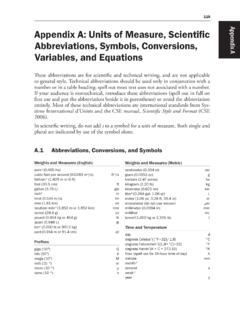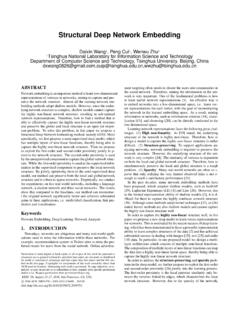Transcription of Introduction to Applied Linear Algebra
1 Introduction to Applied Linear Algebra Vectors, Matrices, and Least Squares Stephen Boyd Department of Electrical Engineering Stanford University Lieven Vandenberghe Department of Electrical and Computer Engineering University of California, Los Angeles University Printing House, Cambridge CB2 8BS, United Kingdom One Liberty Plaza, 20th Floor, New York, NY 10006, USA. 477 Williamstown Road, Port Melbourne, VIC 3207, Australia 314 321, 3rd Floor, Plot 3, Splendor Forum, Jasola District Centre, New Delhi 110025, India 79 Anson Road, #06 04/06, Singapore 079906. Cambridge University Press is part of the University of Cambridge. It furthers the University's mission by disseminating knowledge in the pursuit of education, learning, and research at the highest international levels of excellence. Information on this title: DOI: Cambridge University Press 2018. This publication is in copyright. Subject to statutory exception and to the provisions of relevant collective licensing agreements, no reproduction of any part may take place without the written permission of Cambridge University Press.
2 First published 2018. Printed in the United Kingdom by Clays, St Ives plc, 2018. A catalogue record for this publication is available from the British Library. ISBN 978-1-316-51896-0 Hardback Additional resources for this publication at Cambridge University Press has no responsibility for the persistence or accuracy of URLs for external or third-party internet websites referred to in this publication and does not guarantee that any content on such websites is, or will remain, accurate or appropriate. For Anna, Nicholas, and Nora Danie l and Margriet Contents Preface xi I Vectors 1. 1 Vectors 3. Vectors .. 3. Vector addition .. 11. Scalar-vector multiplication .. 15. Inner product .. 19. Complexity of vector computations .. 22. Exercises .. 25. 2 Linear functions 29. Linear functions .. 29. Taylor approximation .. 35. Regression model .. 38. Exercises .. 42. 3 Norm and distance 45. Norm .. 45. Distance .. 48. Standard deviation .. 52. Angle.
3 56. Complexity .. 63. Exercises .. 64. 4 Clustering 69. Clustering .. 69. A clustering objective .. 72. The k-means algorithm .. 74. Examples .. 79. Applications .. 85. Exercises .. 87. viii Contents 5 Linear independence 89. Linear dependence .. 89. Basis .. 91. Orthonormal vectors .. 95. Gram Schmidt algorithm .. 97. Exercises .. 103. II Matrices 105. 6 Matrices 107. Matrices .. 107. Zero and identity matrices .. 113. Transpose, addition, and norm .. 115. Matrix-vector multiplication .. 118. Complexity .. 122. Exercises .. 124. 7 Matrix examples 129. Geometric transformations .. 129. Selectors .. 131. Incidence matrix .. 132. Convolution .. 136. Exercises .. 144. 8 Linear equations 147. Linear and affine functions .. 147. Linear function models .. 150. Systems of Linear equations .. 152. Exercises .. 159. 9 Linear dynamical systems 163. Linear dynamical systems .. 163. Population dynamics .. 164. Epidemic dynamics .. 168. Motion of a mass.
4 169. Supply chain dynamics .. 171. Exercises .. 174. 10 Matrix multiplication 177. Matrix-matrix multiplication .. 177. Composition of Linear functions .. 183. Matrix power .. 186. QR factorization .. 189. Exercises .. 191. Contents ix 11 Matrix inverses 199. Left and right inverses .. 199. Inverse .. 202. Solving Linear equations .. 207. Examples .. 210. Pseudo-inverse .. 214. Exercises .. 217. III Least squares 223. 12 Least squares 225. Least squares problem .. 225. Solution .. 227. Solving least squares problems .. 231. Examples .. 234. Exercises .. 239. 13 Least squares data fitting 245. Least squares data fitting .. 245. Validation .. 260. Feature engineering .. 269. Exercises .. 279. 14 Least squares classification 285. Classification .. 285. Least squares classifier .. 288. Multi-class classifiers .. 297. Exercises .. 305. 15 Multi-objective least squares 309. Multi-objective least squares .. 309. Control .. 314. Estimation and inversion.
5 316. Regularized data fitting .. 325. Complexity .. 330. Exercises .. 334. 16 Constrained least squares 339. Constrained least squares problem .. 339. Solution .. 344. Solving constrained least squares problems .. 347. Exercises .. 352. x Contents 17 Constrained least squares applications 357. Portfolio optimization .. 357. Linear quadratic control .. 366. Linear quadratic state estimation .. 372. Exercises .. 378. 18 Nonlinear least squares 381. Nonlinear equations and least squares .. 381. Gauss Newton algorithm .. 386. Levenberg Marquardt algorithm .. 391. Nonlinear model fitting .. 399. Nonlinear least squares classification .. 401. Exercises .. 412. 19 Constrained nonlinear least squares 419. Constrained nonlinear least squares .. 419. Penalty algorithm .. 421. Augmented Lagrangian algorithm .. 422. Nonlinear control .. 425. Exercises .. 434. Appendices 437. A Notation 439. B Complexity 441. C Derivatives and optimization 443. Derivatives.
6 443. Optimization .. 447. Lagrange multipliers .. 448. D Further study 451. Index 455. Preface This book is meant to provide an Introduction to vectors, matrices, and least squares methods, basic topics in Applied Linear Algebra . Our goal is to give the beginning student, with little or no prior exposure to Linear Algebra , a good ground- ing in the basic ideas, as well as an appreciation for how they are used in many applications, including data fitting, machine learning and artificial intelligence, to- mography, navigation, image processing, finance, and automatic control systems. The background required of the reader is familiarity with basic mathematical notation. We use calculus in just a few places, but it does not play a critical role and is not a strict prerequisite. Even though the book covers many topics that are traditionally taught as part of probability and statistics, such as fitting mathematical models to data, no knowledge of or background in probability and statistics is needed.
7 The book covers less mathematics than a typical text on Applied Linear Algebra . We use only one theoretical concept from Linear Algebra , Linear independence, and only one computational tool, the QR factorization; our approach to most applica- tions relies on only one method, least squares (or some extension). In this sense we aim for intellectual economy: With just a few basic mathematical ideas, con- cepts, and methods, we cover many applications. The mathematics we do present, however, is complete, in that we carefully justify every mathematical statement. In contrast to most introductory Linear Algebra texts, however, we describe many applications, including some that are typically considered advanced topics, like document classification, control, state estimation, and portfolio optimization. The book does not require any knowledge of computer programming, and can be used as a conventional textbook, by reading the chapters and working the exercises that do not involve numerical computation.
8 This approach however misses out on one of the most compelling reasons to learn the material: You can use the ideas and methods described in this book to do practical things like build a prediction model from data, enhance images, or optimize an investment portfolio. The growing power of computers, together with the development of high level computer languages and packages that support vector and matrix computation, have made it easy to use the methods described in this book for real applications. For this reason we hope that every student of this book will complement their study with computer programming exercises and projects, including some that involve real data. This book includes some generic exercises that require computation; additional ones, and the associated data files and language-specific resources, are available online. xii Preface If you read the whole book, work some of the exercises, and carry out computer exercises to implement or use the ideas and methods, you will learn a lot.
9 While there will still be much for you to learn, you will have seen many of the basic ideas behind modern data science and other application areas. We hope you will be empowered to use the methods for your own applications. The book is divided into three parts. Part I introduces the reader to vectors, and various vector operations and functions like addition, inner product, distance, and angle. We also describe how vectors are used in applications to represent word counts in a document, time series, attributes of a patient, sales of a product, an audio track, an image, or a portfolio of investments. Part II does the same for matrices, culminating with matrix inverses and methods for solving Linear equa- tions. Part III, on least squares, is the payoff, at least in terms of the applications. We show how the simple and natural idea of approximately solving a set of over- determined equations, and a few extensions of this basic idea, can be used to solve many practical problems.
10 The whole book can be covered in a 15 week (semester) course; a 10 week (quarter) course can cover most of the material, by skipping a few applications and perhaps the last two chapters on nonlinear least squares. The book can also be used for self-study, complemented with material available online. By design, the pace of the book accelerates a bit, with many details and simple examples in parts I and II, and more advanced examples and applications in part III. A course for students with little or no background in Linear Algebra can focus on parts I and II, and cover just a few of the more advanced applications in part III. A more advanced course on Applied Linear Algebra can quickly cover parts I and II as review, and then focus on the applications in part III, as well as additional topics. We are grateful to many of our colleagues, teaching assistants, and students for helpful suggestions and discussions during the development of this book and the associated courses.


![arXiv:1607.04606v2 [cs.CL] 19 Jun 2017](/cache/preview/6/2/c/8/2/7/a/7/thumb-62c827a76726812cd50a8dd76dda0eb8.jpg)


